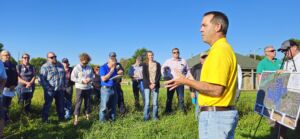
Vermillion River Watershed Tour highlights diversity of investments in water resource protection
About 30 people collaborating on conservation projects and practices attended a tour with the Vermillion River Watershed Joint Powers Organization (VRWJPO) and partners on Thursday, September 25, 2025. Attendees included:
- Dakota County Commissioners Mike Slavik, Bill Droste, and Mary Liz Holberg
- Scott County Commissioner Tom Wolf
- Rosemount Mayor Jeff Weisensel
- Lakeville City Councilmember Dan Wolter
- Lakeville Parks, Recreation, & Natural Resources Committee Member Mark Engler
- Vermillion River Watershed Community Advisory Committee Members Josh Borton and Brad Blackett
- Scott Soil and Water Conservation District Board Member Rob Casey
- Dakota County Deputy Manager David McKnight, Physical Development Division Director Georg Fischer, Environmental Resources Department Director Nikki Stewart, and other staff
- Minnesota Board of Water and Soil Resources (BWSR) staff
- Dakota County Soil and Water Conservation District staff
- Minnesota Department of Natural Resources (DNR) staff
- Minnesota Pollution Control Agency (MPCA) staff
- Staff from the Cities of Lakeville and Rosemount
The group toured four locations:
Lakeville
- North Creek at Foxborough Park Total Suspended Solids (TSS) Reduction Project
Much of the area draining to the North Creek tributary of the Vermillion River was developed before stormwater requirements were implemented. Many of its neighborhoods lack stormwater treatment practices that reduce flow rates or improve water quality—a large portion of the stormwater runoff in the 220-acre subwatershed drains directly into North Creek. Lakeville’s Foxborough Park had the highest estimated pollutant loading area of all those evaluated along this reach of North Creek.
To address impairments, the VRWJPO, Dakota County, and the City of Lakeville constructed a dry pond with a wet sedimentation forebay in Foxborough Park to prevent untreated runoff with total suspended solids (TSS) and total phosphorus (TP) from reaching North Creek. The forebay has a permanent pool to trap sand, debris, and sediment. A rock gabion wall and sand filter bench were constructed to trap smaller pollutants and remove phosphorus.
It is estimated that the project will reduce TSS loading by 18.4 tons/year and TP by 31.8 pounds/year, as well as improve in-stream habitats and provide stormwater flow rate control to the area. The project was completed alongside North Creek channel improvements to reduce TSS and supported by a Clean Water Fund competitive grant from BWSR.
Project partners included the City of Lakeville, VRWJPO, Dakota County, and BWSR.
- East Lake Invasive Fish Barrier and Removals
East Lake, a shallow lake in the city of Lakeville, is on the Minnesota Pollution Control Agency’s Impaired Waters List due to excess phosphorus. While the nutrient can be sourced from watershed runoff, invasive common carp and goldfish are known to exacerbate the issue due to their nature of searching for food in the phosphorus-bound lake bottom sediments. These fish species can make their way into the connected North Creek tributary of the Vermillion River and disrupt ecosystems there as well. Studies found that carp and goldfish biomass within East Lake had reached 192 pounds/acre, with negative water quality impacts associated with these bottom-feeding fish known to take place at biomass densities of 100 lbs/ac.
Blocking East Lake’s connection with North Creek would isolate the waterbody and allow staff to manage the in-lake invasive fish populations. In 2023, the VRWJPO, partnering with the City of Lakeville, received a competitive Clean Water Fund (CWF) grant from BWSR to install a low-voltage electric fish barrier between East Lake and its connection with North Creek in a Dakota County Park Conservation Area. The barrier began operating in spring 2024 and runs during non-winter seasons.
The CWF grant also incorporated two years of invasive fish removals. A contractor experienced in carp and goldfish removals was hired and utilized their attraction to cracked corn to optimize efforts. The contractor baited underwater box nets with cracked corn to congregate fish inside them. The nets were tied to metal poles and suspended out of the water. To remove the fish, the contractor would lift the poles out of the water and put the carp and goldfish into a bucket for safe disposal. They also removed some fish by electrofishing, which was used to define pre- and post-removal fish biomass.
In 2024, 2,798 pounds of invasive fish were removed. 2025 saw even higher numbers, with 5,930 pounds of fish removed. Surveys were conducted before and after removals to assess success in reducing invasive fish biomass, which is now below 100 lbs/ac.
Project partners included the City of Lakeville, VRWJPO, BWSR, and Dakota County.
Rosemount
- Stormwater Infiltration Basins at City of Rosemount Public Works and Police Campus
The City of Rosemount completed construction on a new Public Works and Police Campus in 2024, allowing more capacity for services to a community that has tripled in population since the late 1980s. When designing the campus, the City included two stormwater infiltration basins that went above and beyond VRWJPO Standards’ design requirements for runoff volume reduction. Stormwater infiltration measures like this can reduce stormwater runoff pollution, reduce local flooding risk, and provide groundwater recharge.
Seeking to maximize local partnerships in constructing the facility, the City contacted the VRWJPO about cost-share opportunities. Because the proposed infiltration basins exceeded the watershed’s design standards, the VRWJPO offered $25,000 in cost-share. This included excavation, grading, soil amendments, plantings, and other ancillary costs associated with the work. Landscapers planted native plant species alongside the basins.
The new campus has been open to the public since December 2024. It hosted a session of the Dakota County Soil and Water Conservation District’s Landscaping for Clean Water Design Course in spring 2025, as well as many group facility tours.
- Hoffman Landscaping for Clean Water Raingarden
While VRWJPO staff work with local governments to implement large-scale projects, the counties’ soil and water conservation districts (SWCDs) take the lead on direct landowner outreach. One way the Dakota County SWCD does this is the Landscaping for Clean Water (LCW) Program, founded in 2009 to help Dakota County residents plant raingardens, native gardens, and shoreline restorations.
In LCW, people learn from Dakota SWCD staff how gardens can benefit local water quality and wildlife habitat, then design gardens or shoreline restorations for their own yards. Participants can apply for $250 grants for their projects, funds provided by Dakota County watershed management organizations. Applicants often apply for additional grants from their cities.
The value of LCW is greater than money alone. Grant recipients receive on-site technical assistance from SWCD staff before, during, and after project installation. There is also a free Garden Maintenance class each year. Completed projects include small interpretive signs, educating community members about the environmental benefits of LCW.
Rosemount homeowners Chris and Ashley Hoffman installed a 275-square foot raingarden at their home after taking LCW classes in 2024, using all native plants.
See a map and more detailed descriptions and photos in the tour book.
While these projects and practices improve the Vermillion River and its tributaries, we can all do our part to protect water resources too. See the Vermillion River Watershed website for ideas.


